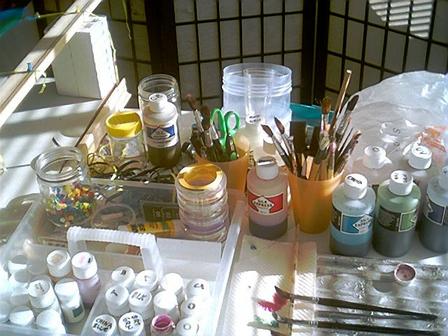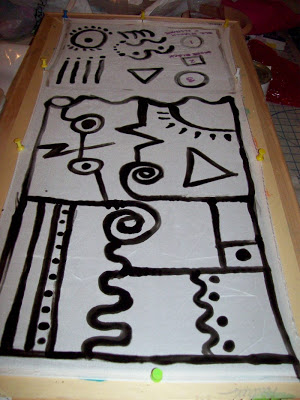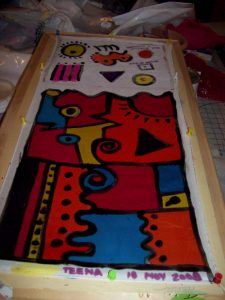Which paintbrushes for silk painting?

When people ask me which paintbrushes I use to paint on silk, I tell them I use a variety … no specific brand, but the brush must be soft, and must be capable of holding a log of dye.
Unlike many silk artists, I do not use huge brushes or sponges to do large backgrounds – I stick to the normal sized brush and paint every inch of silk slowly and carefully. But this doesn’t mean it isn’t time for change – there’s always room to learn new techniques, and to step outside your comfort zone.
You might even learn something new and valuable which could make your task much easier!
When I first started painting I used sable brushes, many of which I still have today. I also have a beautiful old Japanese brush which holds an amazing amount of dye, and as it was a gift the year I started painting on silk, it’s quite a ‘relic’ now and holds a place in my heart … full of memories.
There are now many brushes which are not made from real animal fur, and you will need to test them to see which one ‘feels right’ for you:
- does it bend enough when you use it?
- does it hold a lot of dye?
- is it flexible?
- is it easy to wash and clean?
- is it still soft when you next use it?
If you answer ‘yes’ to these questions and the weight of the brush feels good in your hand, then you’ve found a painting partner.
Below is a photo of my paints and brushes – you can see I write on the lids of small plastic bottles, to quickly see which colour is inside. I also lay my brushes down on a tray when working with them – first I put down paper towel, then a chopstick to act as a ‘rest’ for the brushes, and then I put a dab of paint on the paper towel to mark the position of that particular brush:

Paintbrush Tips & Care
Always treat your paintbrushes with respect
always wash your brushes at the end of every painting session, so they’ll keep their good shape for years to come
if you’re travelling with your paintbrushes, pack them sensibly so they won’t get scratched or rub against each other
keep paper towel handy so you can always quickly wipe excess dye off if necessary.
If you treat your paintbrushes properly, they give you years of loyal service.
How to clean your paintbrushes
The care of paintbrushes is very important, and also very easy to do.
Wash your brushes under running water [warm is fine, hot is not necessary], massaging the brushes gently with your fingers. If you think the brushes may not be clean enough, keep an old bar of soap at the sink; place it in the bottom of the sink and let it get wet, then press the brush gently onto the soap and move it in a swirling motion to make a lather.
Now gently massage the soap into the bristles with your fingers, and you may notice the lather changing colour from the dye it has found … rinse this off well, repeat if necessary.
How to store your paintbrushes
After I’ve washed my paintbrushes, I wipe them with paper towel [not rub] and gently press the towel around the bristles to absorb any left over moisture. I then stand them up in glass jars with the brushes pointing to the ceiling.
When travelling with my brushes, I have found a neat way of storing them. I have a bamboo mat [generally used as a table mat] which I lay flat. I have a piece of thin soft fabric [flannelete] which is cut slightly smaller than the mat. I lay the brushes on the mat about an inch apart, and then I slowly roll up the mat with fabric and brushes inside. When finished I simply tie a piece of ribbon around the centre, or you could even use a rubber band or hairband. I prefer ribbon as it adds a dash of colour, and rubber bands may rot over time.
 Many people ask me about GUTTA [pronounced ‘goo-tah’] and I tell them about what I learned as a new Silk Artist many moons ago.
Many people ask me about GUTTA [pronounced ‘goo-tah’] and I tell them about what I learned as a new Silk Artist many moons ago. Those days really were magical, as I learnt to paint on silk and took to it like a pro from day one.
Those days really were magical, as I learnt to paint on silk and took to it like a pro from day one.